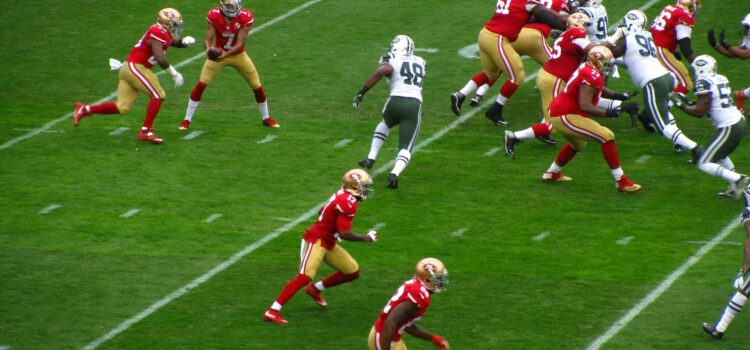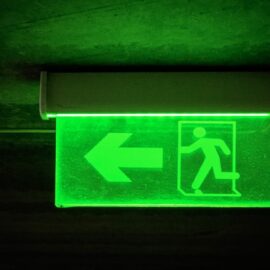

This article is an excerpt from the Shortform book guide to "The Blind Side" by Michael Lewis. Shortform has the world's best summaries and analyses of books you should be reading.
Like this article? Sign up for a free trial here .
Who was Michael Oher, high school athlete, before he was an NFL player? How did sports help shape his future?
For Michael Oher, high school at Briarcrest started out with difficult, like the rest of his academic career. But Michael Oher’s life changed when he got involved in school sports and met the Tuohy family.
Read more about Michael Oher, high school, and how his luck changed.
Michael Oher in High School: A Player Like No Other
Michael Oher’s high school sports prospects improved when he transferred to Briarcrest. At the school,
From the start, Michael Oher’s high school tape was a mystery to Lemming. He wasn’t mysterious simply because of his seemingly impossible skills on the field. Lemming also couldn’t find any information on him. In all his years of scouting, any player that sparked his interest could always be researched. There would usually be national stories or local news articles highlighting a player’s accomplishments.
Stranger still was the school Michael attended. Michael went to Briarcrest Christian School in Memphis, a small private school not known for football or black students. When Lemming called the school to ask for Michael’s contact information, he learned Michael didn’t have a phone number or home address, and no one seemed to be representing this kid. This was odd because top players always had a team of handlers, from parents to coaches to informal agents. Lemming knew the only way he was going to learn about Michael Oher was if he drove to Memphis to meet him.
Briarcrest agreed to set up a meeting between Lemming and Michael at the University of Memphis. When Michael walked into the conference room, Lemming was taken aback by his size. He was so big, he almost didn’t fit through the door. But Michael wasn’t a soft 300 pounds. He was solid, built sturdy in all the right ways. He also had long arms and giant hands.
Lemming started the interview, asking the same series of questions about college, the future, and Michael’s goals in life. Michael sat silent. So Lemming decided to have him fill out a questionnaire. Michael took the piece of paper and set it off to the side. Lemming tried again, this time handing Michael what was essentially the golden ticket of high school football—the Army all-star game registration form. Again, Michael took it and set it to the side.
Lemming realized this visit was going nowhere and excused Michael. Never before had he encountered this situation in his life, and he didn’t know how to explain it. He assumed that Michael’s reticence was a sign of a bad attitude or trouble. But he didn’t write Michael completely off because, although quiet, he’d been polite. He also knew that if this kid played left tackle, he’d be a number one pick for the NFL without question.
What Lemming didn’t realize was that Michael had no idea who Lemming was or what he did. He didn’t consider himself a football player, and he’d certainly never played left tackle before. The mystery of Michael Oher continued. Lemming was determined to see more of Michael Oher’s high school football career.
The Kindness of Strangers
For Michael Oher, high school wasn’t always easy. Michael struggled with many issues and a difficult past before his success.
The path that eventually led to Michael’s acceptance on the Briarcrest football team and on Lemming’s radar was paved by the fortitude and kindness of several individuals, the first of whom was Tony Henderson, the closest person to an official guardian for Michael.
Big Tony, as he was called, was from an impoverished, gang-ridden community in Memphis called Hurt Village. The village was once housing for working-class white families, but after desegregation of public schools, white flight took hold. The black community took over Hurt Village and most of the west side of Memphis, and born-again white Christians developed their own communities on the east side. Christian schools sprouted up everywhere, the largest of which was the Briarcrest system.
Briarcrest Christian School was as far east as you could get and still be in Memphis. There were a handful of black students in the school’s history, but most of them were not Memphis natives and were from upper-class families. Never had a poor black child attended the heralded Christian school, but that was about to change in 2002 when Big Tony walked in.
Big Tony was at Briarcrest because of his son, Steven, a highly intelligent black teenager. Big Tony had made a promise to his dying mother to take Steven out of public school and enroll him in a Christian school on the east side so he could become a preacher. But the two weren’t alone as they drove to Briarcrest that first day. Michael was with them.
Big Tony coached youth football and basketball and often recruited young players from Hurt Village. On one of these visits, he saw 15-year-old Michael on the basketball court. Michael’s size and skill level caught Tony’s attention. Big Tony could see that Michael was headed down a bad road and decided to help him channel his energy into sports. Michael had been sleeping on Big Tony’s floor for several months by the time they made the initial visit to Briarcrest.
The decision to enroll in Briarcrest was due to the new head basketball coach, a man named John Harrington, whom Big Tony had known when John coached in the public schools. Big Tony told John about the two boys, and John referred them to the football coach, Hugh Freeze, who’d had an 8-year storied career with both the football team and girls basketball team.
Although Hugh was impressed with Big Tony’s desire to get Steven a better education, he doubted whether the boy’s grades were actually good enough to get into Briarcrest. He also doubted whether Big Tony would be able to afford the tuition. He also didn’t think much when Big Tony told him about Michael, a large kid who played basketball but might be of benefit on a football team. It wasn’t until the boys walked into the office that Hugh had a change of heart.
After shyly peeking around the corner, Michael walked in and filled the room like a house. He was close to 6’5” and around 330 pounds at 16. Hugh told Big Tony to bring him the boys’ transcripts, and he’d see what he could do.
A Boy With No Future
Steven was a shoo-in for Briarcrest because of his excellent transcript, but Michael’s was the antithesis. He’d attended 11 schools in 9 years, was truant often, and had repeated both the first and second grades. Michael tested at an IQ of 80 and had no discernable learning skills. He’d been moved up the chain of the public school system, which tended to give every student the minimum grade required to graduate to become someone else’s problem. Michael’s transcript showed the consequence of this educational history: a 0.6 overall GPA. There was no way this kid was getting into this school.
Yet, Hugh still sent the transcript to Principal Steve Simpson, also new to Briarcrest, who was kind-hearted despite his cool demeanor. Simpson understood what had happened to Michael in the public school system, having come from that system himself, but there was nothing he could do. He told the large mute boy and Big Tony that he couldn’t recommend entry at this time. But if Michael did well in a home-study program for the Fall semester, he could enroll in Briarcrest.
What Principal Simpson failed to realize was that Michael had no understanding of how to study and no support system to help him. Big Tony was too busy with work to help him, and Michael was struggling. Big Tony didn’t know what to do now that it was too late to enroll in regular public school. When Simpson realized that the false hope he’d given them had hurt the boy’s education, he felt compelled to make it up to him. He convinced the school’s president to give Michael a chance. In the middle of the first semester, Michael became a student at Briarcrest on the condition that he couldn’t play sports unless he maintained good grades.
This task was harder than anyone imagined. Michael had been given every test possible growing up to determine why he struggled so much in school. All the tests concluded that he did not have a learning disability and was just stupid. This was the information Jennifer Graves, the special needs program director, was given on Michael’s first day. The fact that Michael didn’t speak or look up from the ground didn’t help matters. She had no idea why Michael was let into the school or how she was supposed to help him, but the task had fallen to her.
Jennifer learned how much Michael didn’t know about everything, not just school. He didn’t know the basic mechanics of the English language, what the ocean was, who the tooth fairy was, or how to interact with others. But he was kind. After she scolded him for scaring a young child who’d tried to talk to him, she saw Michael smiling and engaging with a group of children the next day.
But kindness didn’t pass tests, and Michael rarely even started them. The other teachers were becoming resentful of this large black child incapable of learning, so Jennifer and another teacher decided to administer his next test verbally one-on-one. They quickly saw that Michael was overwhelmed by the complicated questions on the test, but he did better if they broke them down into simple phrases and walked him through them word for word. After an hour, they realized Michael wasn’t stupid. He was absorbing information but didn’t know what to do with it.
Michael scored a C on the test, which brought his semester grade up from an F to a D. He still couldn’t play sports, but he could stay at the school.

———End of Preview———
Like what you just read? Read the rest of the world's best book summary and analysis of Michael Lewis's "The Blind Side" at Shortform .
Here's what you'll find in our full The Blind Side summary :
- How Michael Oher went from the projects in Memphis to the NFL
- Why the combination of size and speed became essential for football stars
- How Oher was taken in by the wealthy Tuohy family






